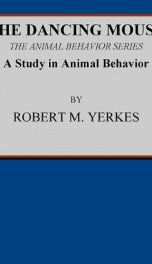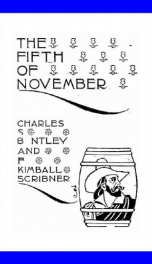The Dancing Mouse

from the PREFACE : This book is the direct result of what, at the time of its occurrence, seemed to be an unimportant incident in the course of my scientific work-the presentation of a pair of dancing mice to the Harvard Psychological Laboratory. My interest in the peculiarities of behavior which the creatures exhibited, as I watched them casually from day to day, soon became experiment-impelling, and almost before I realized it, I was in the midst of an investigation of their senses and intelligence. The longer I observed and experimented with them, the more numerous became the problems which the dancers presented to me for solution. From a study of the senses of hearing and sight I was led to investigate, in turn, the various forms of activity of which the mice are capable; the ways in which they learn to react adaptively to new or novel situations; the facility with which they acquire habits; the duration of habits; the roles of the various senses in the acquisition and performance of certain habitual acts; the efficiency of different methods of training; and the inheritance of racial and individually acquired forms of behavior. In the course of my experimental work I discovered, much to my surprise, that no accurate and detailed account of this curiously interesting animal existed in the English language, and that in no other language were all the facts concerning it available in a single book. This fact, in connection with my appreciation of the exceptional value of the dancer as a pet and as material for the scientific study of animal behavior, has led me to supplement the results of my own observation by presenting in this little book a brief and not too highly technical description of the general characteristics and history of the dancer. The purposes which I have had in mind as I planned and wrote the book are three: first, to present directly, clearly, and briefly the results of my investigation; second, to give as complete an account of the dancing mouse as a thorough study of the literature on the animal and long-continued observation on my own part should make possible; third, to provide a supplementary text-book on mammalian behavior and on methods of studying animal behavior for use in connection with courses in Comparative Psychology, Comparative Physiology, and Animal Behavior. It is my conviction that the scientific study of animal behavior and of animal mind can be furthered more just at present by intensive special investigations than by extensive general books. Methods of research in this field are few and surprisingly crude, for the majority of investigators have been more deeply interested in getting results than in perfecting methods. In writing this account of the dancing mouse I have attempted to lay as much stress upon the development of my methods of work as upon the results which the methods yielded. In fact, I have used the dancer as a means of exhibiting a variety of methods by which the behavior and intelligence of animals may be studied. As it happens the dancer is an ideal subject for the experimental study of many of the problems of animal behavior. It is small, easily cared for, readily tamed, harmless, incessantly active, and it lends itself satisfactorily to a large number of experimental situations. For laboratory courses in Comparative Psychology or Comparative Physiology it well might hold the place which the frog now holds in courses in Comparative Anatomy.
Info about the book
Author:
Series:
Unknown
ISBN:
1419158538
Rating:
2.4/5 (5)Your rating:
0/5
Languge:
English
What readers are saying
What do you think? Write your own comment on this book!
write a commentGenre
if you like The Dancing Mouse try:
Other books by this author
Do you want to exchange books? It’s EASY!
Get registered and find other users who want to give their favourite books to good hands!



















